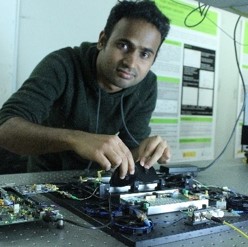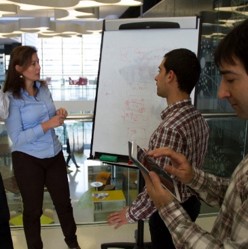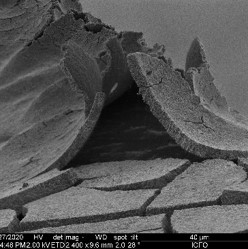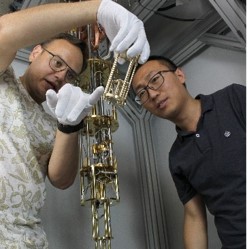ICFO decide game
Group 1 – Participant 3
Story cards
Read all the cards from this category, choose the one that looks more interesting to you and explain it to the rest of the group.
ernesto espinosa
Story Card 14
When I was studying at the Academy of Fine Arts, I would have never thought of pointing a laser at a picture by Leonardo da Vinci like I am doing right now! Don’t worry, I don’t want to damage it: the laser allows me to clean it and to bring it back to its original splendor.
Lasers and photonic analysis techniques are very useful tools for restorers of works of art like me: they allow us to analyze different aspects of works of art (such as pigments, or the process followed by the artist) without jeopardizing the integrity of the pieces. My work mixes art and science: I’m sure Leonardo himself would love it!
photonics everywhere
gerard grau
Story Card 15
This year I started the master's degree in Photonics in Barcelona. In one of the subjects, I discovered that photonics has a lot to do with my other passion: drones. If we fill these small planes with photonic sensors, we can get valuable information about places that would be difficult to reach. This makes drones not just fun toys, but important tools for studying the environment, searching for oil, gas, or mineral deposits, monitoring areas of natural disasters or crops.
information and cYberseCuriTY
núria navas
Story Card 17
A few days ago, I saw my two-years-old daughter trying (unsuccessfully) to slide the page of a newspaper with her finger. For a person like her, who was born in a world where there are screens everywhere, even on the fridge, it is natural to think of being able to interact with any surface or written word. This would not be possible if in recent years the screens had not improved so much, gaining in definition and functionality. Who could have imagined being able to interact so intuitively with a machine a few decades ago?
information and cybersecurity
info cards
Read all cards from this category, choose the two that look more interesting and explain them to the rest of the group.
quantum cryptography
Info Card 3
We share on a daily basis a lot of private information (personal, financial or health data) that could be intercepted: the cryptographic protocols that currently protect them would not work with more powerful computers in the future.
A solution could come from quantum physics: it allows you to design cryptographic protocols that would withstand the attacks of any computer (present or future). There are still many technological challenges to the integration of quantum cryptographic systems into the telecommunications network: solving them is the goal of CiViQ, a European Quantum Flagship project that ICFO coordinates and in which others research centers, universities and large and small companies participate, including Quside, an ICFO spin-off founded in 2017.
Photo: One of the ICFO laboratories where technologies for quantum cryptography are being developed
information and cybersecurity
knowledge and technology transfer
Info Card 8
ICFO puts the maximum effort in transforming the knowledge generated there into a positive impact on society in the form of products and technologies in collaboration with the industry or through the creation of spin-offs.
ICFO has obtained more than 100* patent families in the fields of health, information and energy. These include innovations in microscopy and optical manipulation, nanotechnology devices, solar cells, graphene sensors, laser systems, advanced displays, 3D printing, wearable devices, quantum technologies and compact sensors for use in hostile environments.
ICFO has surrounded itself by an ecosystem of companies with which it collaborates in different industrial projects, many involving its 9* spin-offs and as well as others still in the incubation stage.
(*) data updated on October 2020
photonics everywhere
nanotechnology
Info Card 9
If we split the diameter of a hair into a thousand parts, we would get to the scale of the nanoparticles that are made in ICFO. Despite being so small, these particles are useful for different innovative technologies.
At ICFO, many people are exploring the nanoworld, trying to improve our knowledge of the new phenomena that emerge at this tiny scale. They also aim to develop new technologies, such as new materials for mobile phones and wearable devices, diagnostics and treatment of diseases, sensors of photons and solar cells.
Photo: Carbon structure seen with an electron microscope. Some nanotubes can be seen inside the "cave".
photonics everywhere
graphene with a twist
Info Card 14
Graphene is a material of a single layer of atoms with incredible properties: transparent, resistant, flexible and an optimal conductor of electricity and heat.
In 2018 it was discovered that two superimposed layers of graphene with a small rotation between them could transform this already interesting material in itself into a superconductor.
This was very important news for the scientific community and it even was published in the New York Times! It allows us to better understand the phenomena that take place in superconductors and potentially to design materials that conduct electricity without losses at room temperature, reducing the waste that takes place with current materials.
ICFO is one of the few laboratories in the world where it is possible to transform graphene into a superconductor.
Photo: Part of the ICFO team working on this project with the device that allows to observe the properties of graphene
photonics everywhere
thinking cards
Read all the cards from this category, choose the one that looks more interesting to you and explain it to the rest of the group.
there are more urgent issues
Thinking Card 4
Science and technology have improved and are improving the quality of our lives. However, there are still many urgent and important problems that require immediate solutions that scientific research cannot offer us directly and quickly. Perhaps we should focus our efforts on reducing social inequality, unemployment, hunger and poverty. Or can science and technology help in these aspects as well?
global science
Thinking Card 14
Science is an international activity: the vast majority of scientific discoveries are made by multinational teams and result from collaborations between institutes and companies in different countries.
People in the world of science often move to expand their experience, so it is very common to find people from different countries in a research center. The cultural mix creates an open and tolerant environment that helps the creation of new and original ideas that allow research advancement.
So does it make sense to associate an important scientific discovery with a country, as we can often read in the news?
DECISIon
The time and resources available to solve important problems affecting society are limited. Imagine being part of the commission that has to decide how to invest the money for photonics research at European level for the coming years: knowing that photonics benefits society in many different ways, how would you distribute funds among the different research fields in photonics?
This is not an individual decision: each group must come to a unanimous conclusion by discussing correctly and rationally based on the facts that you have learned so far. There is no right or wrong answer. Like many things in life, it depends on the point of view you assume, the priorities you set, ...
light for health
Option 1
The pandemic that arose in 2020 taught us that public health is an important sector that affects many more aspects of society. A tiny virus can affect the lives of millions of people in all its aspects, not only health, but also the economy, industrial structure, labor market ...
That’s why it’s important to focus most of our efforts on research projects that can improve and care for people’s health.
light for information and cybersecurity
Option 2
We live in the information age. More and more companies and institutions are collecting and analyzing large amounts of data to improve industrial processes and services for the population. In addition, digital technologies are essential to communicate with each other, whether for work or fun. If information systems fail, strategic structures such as energy networks, traffic control, hospitals, governments, etc. fail, too. Thus, ensuring data security for quick and massive data transfer is of fundamental importance for a digitized society like ours.
That is why it is important to focus most of our efforts on research projects that can improve data collection, analysis, transmission and security.
light for energy and the environment
Option 3
We are in the middle of a climate emergency: to be able to solve it we need new environmental policies and the commitment of society as a whole. Science and technology can accelerate the change of paradigm that we need to save the planet with discoveries and innovative technologies. If we do nothing now, the Earth will be uninhabitable and unsustainable, but there’s still time.
That’s why it’s important to focus most of our efforts on research projects that can help us take care of our planet.
photonics everywhere
Option 4
Photonics is everywhere and has a positive impact in many different aspects of our lives. Sometimes, the same technology (such as the laser) can improve health, information and care for the environment at the same time. There are many global issues and it is difficult to set a priority, especially because they are interconnected.
That’s why it’s important not to focus our efforts on a single field of application: it’s better to diversify our efforts to have more chances of success.













